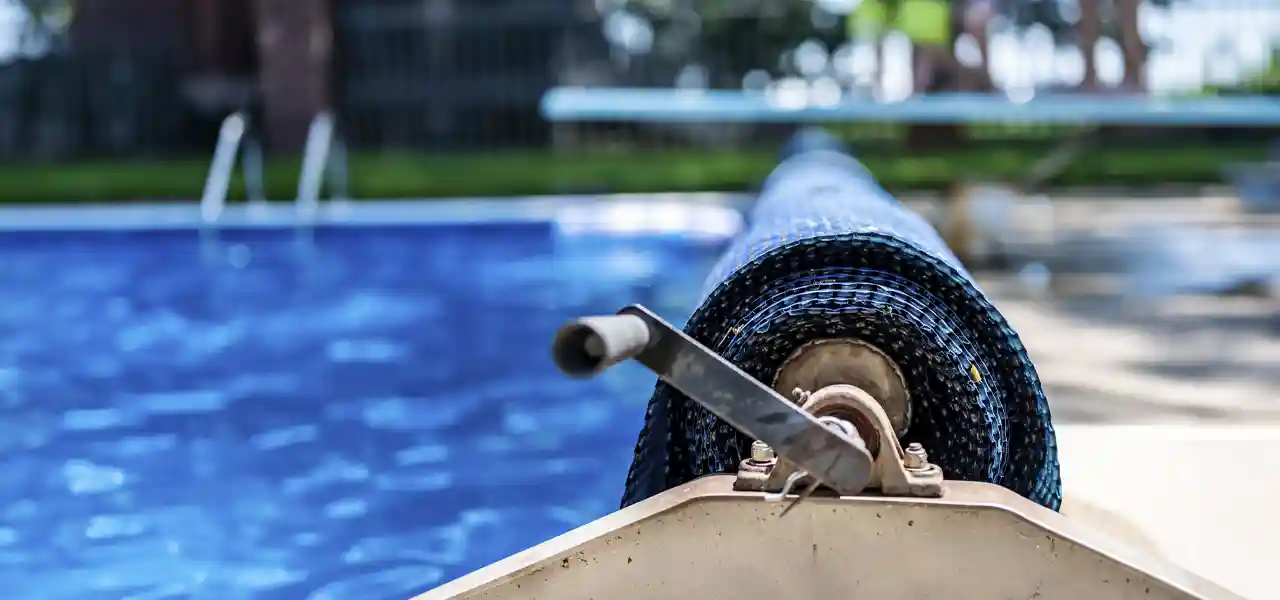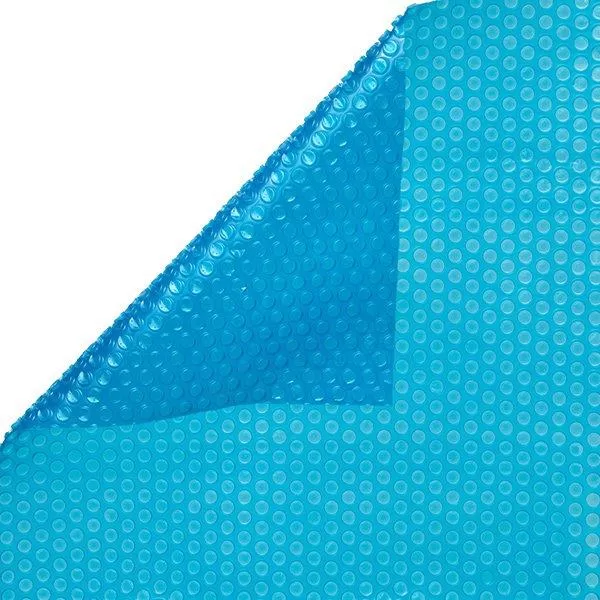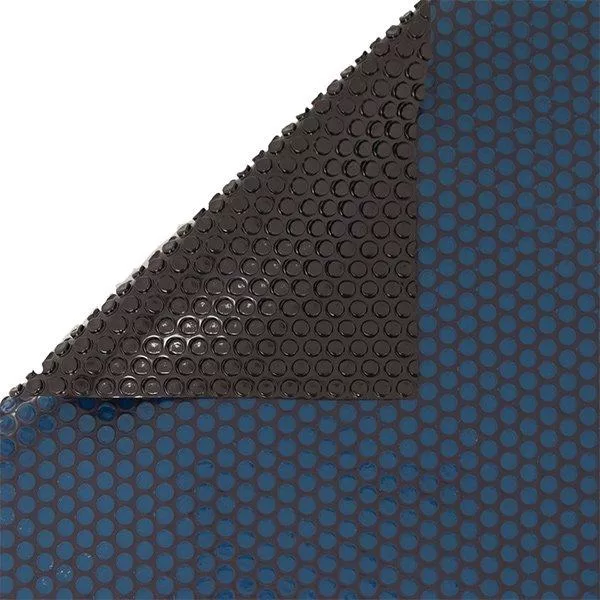FREE Standard Shipping On All Orders $100 or More!*

Solar Pool Cover Installation, Use, and Care
Solar covers help maintain warmer water as well as prevent the evaporation of water and chemicals, both which save you money! There are several ways to solar heat your pool, but solar covers are the most effective way to harness the sun's energy.
Solar Cover Selection
A recent study shows that Solar Blankets stop 5-times more evaporative heat loss, when compared to Liquid Solar Covers and Solar Sun Rings.
We like to say that we have a solar blanket for every budget. Once you select the size of solar blanket - you'll be presented with several choices of color and thickness. Solar covers come in 8 mil, 12 mil and 16 mil - each with longer warranty periods.
For color choices, you can select from our standard Blue solar blankets in 8 or 12 mil, or upgrade to our Blue/Black solar cover in 12 mil, with a dark bottom to trap more heat in the pool. For the most durability and highest heat gain, look at the 16 mil Ultra Clear (opaque actually) blankets. We offer a wide selection of solar covers to meet any budget, and pool heating needs.
8 Mil Solar Cover
- Thinnest cover, lightweight
- Lowest price
- Increases pool temperature up to 10ºF
- 3-year limited warranty
12 Mil Solar Cover
- Happy medium for thickness and weight
- Moderate price
- Increases pool temperature up to 15ºF
- 7-year limited warranty
16 Mil Solar Cover
- Thickest cover, heavier weight
- Highest price
- Increases pool temperature up to 18ºF
- 8-year limited warranty
How to Compare Pool Solar Covers
Solar blankets are made from a UV-stabilized form of polyethylene or polypropylene material. Larger pool blankets are made from rolls of material that are heat sealed together. The better solar pool covers are made of an extruded one-piece material, rather than a laminated top and bottom, and will be thicker, with longer warranty periods.
Solar Cover Sizing

To determine what size solar pool cover you need, simply measure the longest and widest points of the pool. When the cover is installed, it's best to completely cover the water surface, so there aren’t any gaps for heat to escape. Solar covers are easily cut to fit - freeform or kidney shaped pools use an rectangular size that completely covers the pool, and trim it down to fit the pool shape.
Solar covers are available in round, oval or rectangular shapes. You may notice we sell in-ground and above ground solar covers, but there is no difference in the material. Generally, oval and round covers are installed on above ground pools and rectangular covers on in ground pools, but depending on your pool shape - you may be better off purchasing oval or round above ground solar covers for your in-ground pool.
“L” shaped pools or other large pools may find it better to buy two (or more) smaller solar blankets, instead of buying one larger cover and cutting it to size. It may be cheaper overall, in addition to reducing material waste.
For pools with a step section that needs to be covered, don’t worry about purchasing an oversized blanket and cutting to size, just purchase a step section piece. In The Swim offers 4’x8’ pieces of solar blanket for step sections in 12mil and 16mil material.
Solar Cover Installation
If your pool is rectangular, round or oval and you were able to find a cover that is your exact pool size, then the job of installing your solar blanket is pretty easy – simply lay the cover on the pool with the bubble side facing down, and the smooth side facing up.

Place some light weights around the cover to hold it in place. Nothing too heavy or sharp, of course, you don’t want to damage the cover. Winter cover water tubes would be a good choice. Don’t worry about the cover being drum-tight, it should be floating on the water, and evenly overlapping the pool coping.
Once you have the cover in place, carefully cut two sides of the solar cover around the perimeter of the pool, cutting right up against the coping inside edge, to make sure there won’t be any gaps between the cover and the pool wall when it is lying on the water. When half of the cover is cut, use your pool brush to push the cut sides up against the edge of the pool, and to smooth out the blanket, removing air bubbles beneath.
For pools with lots of surrounding trees and debris, some folks like to cut the cover larger, to keep leaves from falling in around the edges. This works best on rectangular pools - it's harder to get the solar blanket to lay flat against curved wall sections.
Solar Cover Use
Generally speaking, you should have the solar cover on the pool whenever the pool is not being used. During the day, having the cover on the pool helps to prevent water and chemical evaporation in the hot sun and also warms the pool. At night it will help to insulate the water, to retain the heat you have gained throughout the day.
There are times when you should not use a solar cover. Remove the cover during heavy storms and wind events, to prevent damage from flying debris. Remove the cover before shocking a pool, and leave it off until chlorine levels drop below 2.5 ppm. Low pH and alkalinity, and low hardness (soft water) can also damage solar blanket material.
Solar Cover Care
Solar covers are durable as they can be while remaining flexible, but are subject to damage from unbalanced water, and quickly deteriorate with high levels of chlorine. Important to note - as chemical damage is not covered under any warranty.
High Chlorine:
Solar covers should never be used after shocking or super-chlorinating the pool. Leave a solar cover safely stored in the shade whenever chlorine level is higher than 2.5 ppm.
Low pH:
Solar covers will also degrade in acidic pH levels, when pH falls below neutral 7.0.
Low Calcium:
Very soft water with calcium hardness levels below 150 ppm, can literally suck the plasticizers directly out of your solar blanket, making it rigid and crispy.
Using solar blanket reels can extend the life of your solar blanket. Keeping it rolled up prevents pinching and folding, and protects the cover from (some) damaging UV rays. Reels also make it easier to clean the cover while removing it from the pool, and lets you roll the cover out of the way, or into the shade.
Solar Degradation:
When rolled on a solar reel, or folded on the deck, layers of solar blanket material focus and magnify the sun's rays onto deeper layers, which weakens the material and can discolor the cover with a 'sun-burn' (also not covered under warranty).
It's a bit ironic that the sun can damage a solar blanket, but if left rolled up or folded in one sunny spot during hot summer months (or all winter long), solar covers will fail faster.
Cover your cover while on the reel with the Solar Cover Poly Tarp, a long piece of white plastic with Velcro attachments, or for greater protection use the heavy-duty Solar Cover Winter Cover, both available in several sizes to fit your reel perfectly.
Winter Solar Cover Care

During winter, store your solar blanket out of the elements, indoors if possible, as very cold cold temps can cause cold cracking. Do not leave a solar blanket on the pool during winter.
Clean and dry your solar blanket, then fold or roll it up for safe storage. A large Rubbermaid bin or upright drum can be used for maximum protection from sun, dirt and nesting rodents.
The US Department of Energy would like pool owners to increase their use of pool covers, to reduce energy demands and pool heater emissions. Do your part by investing in a solar blanket that will save you money and make your swimming pool more enjoyable.

